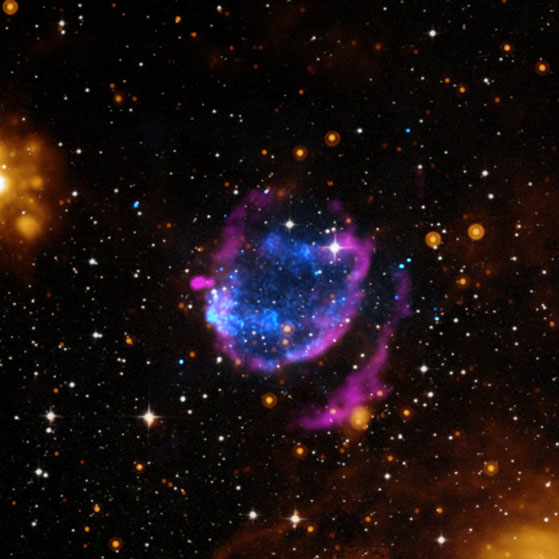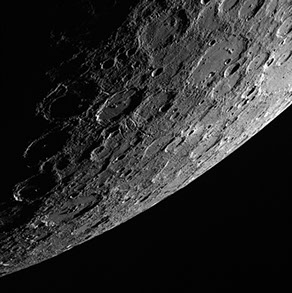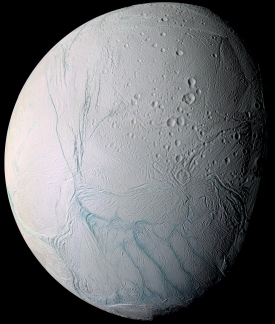



April 2014
Lunar Eclipse
For those of you in North and South America, a lunar eclipse will take place this month. The event will be on April 14th or 15th depending on your time zone. Totality will occur at 07:06 UT the morning of the 15th, this corresponds to 3:06 AM Eastern time in the US and 12:06 midnight on the US west coast. It will be visible over North America, South America and the islands of the Pacific. Totality will last approximately 80 minutes.
During a lunar eclipse, the earth passes between the moon and sun blocking all the sunlight falling on the moon. But the red light in the spectrum is bent while traveling through the earth's atmosphere, so even though no sunlight is falling directly on the moon, the red light being bent through earth's atmosphere does fall on the moon. This makes the moon appear red in color during totality.
Unusual Supernova
Scientists are trying to figure out the strange unusual data they have received from supernova
G352.7-0.1 (G352 for short). G352 is located in the Milky Way about 24,000 light years from Earth.
The remains of the supernova has swept up a very large amount of material, equivalent to 45 times the mass of the Sun. The X-Ray emission is dominated by the hotter debris from the explosion instead of the cooler debris. The cooler material in a supernova is swept up by the expanding shock wave. Usually, supernova the age of G352 produce X-rays that are dominated by the cooler material that had been swept up. G352 is estimated to have exploded about 2,200 years ago. So far, scientists have not been able to explain this.
Another curiosity in G352 is that the radio and the X-rays are very different in shape. The radio emission is an ellipse and the x-ray emission fills in the center of it. This is revealed in the photo below. The X-ray data from the Chandra space telescope is in blue, the radio data from the Jansky Very Large Array is in pink. The orange color is infrared light captured by the Spitzer space telescope and the white is visible light recorded by the Digitized Sky Survey.
A third curiosity is G352 is that there has been no neutron star detected in the remnant. It could be that the neutron star is simply too faint to be detected or it could be that the supernova created a black hole.

PHOTO: X-ray - NASA/CXC/Morehead State U/T.pannuti et al; Optical - DDS; Infrared - NASA/JPL-CalTech; Radio - NRAO/VLA/Argentinian Institute of Radio Astronomy/G. Dubner
Visit our sponsors.
For advertising opportunities on this page and our videos, contact
Upcoming Launches
Date: April 14
Launch Vehicle: Falcon 9
Launch Site: Cape Canaveral AFS, Florida - Complex 40
Description: Space-X will be the third commercial resupply mission to the International Space Station
Big Bang Evidence
Around 13.8 billion years ago, our universe was born in a cosmic explosion known as the Big Bang. According to cosmic inflation theories, the universe then expanded by 100 trillion times in less than a trillionth of a trillionth of a trillionth of a second. If this theory is correct, then gravitational waves would have rippled through the fabric of space itself. Scientists now believe they have found the evidence.
Studying the Cosmic Microwave Background data with various instruments including the European Space Agency's Planck satellite, scientists have been able to examine the universe in its very early stages of existence. But the direct evidence of the gravitational waves eluded them. Until now.
Using the BICEP2 telescope at the South Pole, scientists have found, for the first time, direct evidence that gravitational waves rippled through the universe in the first micro-seconds after the Big Bang. Just after the Big Bang itself, space itself was ripped apart, expanding exponentially, in what is known as Inflation.
The gravitational waves produce a swirly pattern in polarized light called "B-Mode" polarization. This "B-Mode" polarization is what BICEP2 detected. It is seen as a twist in the directional properties of the Cosmic Microwave Background. Only gravitational waves moving through the Universe in this inflation period could have produced this. It is the strongest evidence yet to support the theory of cosmic inflation.
The data is now being analyzed by scientists around the world and others hope to replicate these findings. The BICEP2 program is run by JPL, CalTech, Stanford Univ., Harvard Univ., and the Univ. of Minnesota.
Mercury

Mercury is the smallest planet and the planet closest to the Sun. Since 2011, NASA's Messenger spacecraft has been in orbit around the planet. Initially a one-year mission, the mission has twice been extended and now will continue until March 2015 when Messenger's fuel will run out and the spacecraft will crash into the surface.
Messenger has photographed and mapped 100% of the surface of the planet. It has acquired over 150,000 images so far and collected extensive data.
When Messenger's mission ends, the European Space Agency will be launching Bepi-Columbo to Mercury to continue our study of this facinating planet.
Photo credit: NASA/Johns Hopkins Univ. Applied Physics Lab/Carnegie Institution of Washington
Mercury is about a third of the size of Earth. Of all the inner planets, only Earth and Mercury have a global magnetic field. Mercury is the second densest planet in the solar system with a density 5.3 times that of water.
Sixty percent of the planet's mass is made up of a huge iron core. This iron core is nearly 4000 km in diameter (the planet itself is only 4880 km in diameter). It is covered by only a thin rocky surface that is only a little over 400 km thick. Although some of the core must still be liquid iron, part of it has cooled and become solid. This has caused the outer surface to contract. Messenger data has determined that Mercury has shrunk by over 7 km since the crust formed over four billion years ago.
Surface temperatures on the planet vary from between 425 C to -180 C. This means that water-ice could exist in the craters that are in permanent shadow.
Mercury has some interesting large features along with all the craters that populate its surface. Caloris Basin is the largest feature at over 1,300 km in diameter. Enterprise Rupes is 1,000 km long and 3 km high making it a huge mountain range.
On Mercury, the mountains are formed because the crust is shrinking. Unlike the Earth, which has plate tectonics, Mercury only has a single plate. As the inner core cools, the crust contracts in areas, producing the mountain ranges.
Mercury is a fascinating place in spite of its small size and lack of moons. The data that Messenger has sent back, along with data still to come, is revealing a place like no other and helping scientists understand more of the processes and science that created planets all over the universe.
Enceladus
Enceladus, the icy moon of Saturn, has been seen shooting jets of water into space since first observed close up by the Cassini spacecraft in 2005. These jets of ice and water vapor shoot out of fractures on the surface of the moon. These fractures appear as blue stripes in the southern hemisphere.
Cassini has made three separate fly-bys of Enceladus since then coming to within 100 km of the surface (twice over the southern hemisphere and once over the northern hemisphere).
During each fly-by, the spacecraft was pulled slightly off course by the gravity of the moon. By measuring how far the spacecraft was deviated from its course at points along its route, scientists were able to infer the distribution of mass inside the moon.
They measured a negative mass anomaly at the surface of the south pole and a positive anomaly 30-40 km below. This indicates that Enceladus' interior is asymmetric, an ice shell overlaying liquid water. The data points to a regional sea beneath the southern hemisphere surface as opposed to a global underground ocean. Combined with photography from Cassini during the fly-bys, this is the most logical explanation of conditions that would produce the plumes shooting out of Enceladus.
Photo: NASA/JPL/Space Science Institute
Ring Around an Asteroid
The ESO (Southern European Observatory) La Silla Observatory in Chile, along with seven other observatories in South America have discovered rings around the asteroid Chariklo. It is the first discovery of rings around an object other than a planet. Previously, the only known objects with rings were the giant gas planets Jupiter, Saturn, Uranus and Neptune, with Saturn's being the largest and most visible.
Chariklo orbits between Saturn and Uranus. It is small, only 250 km in diameter. Two sharply confined rings of only seven and three kilometers wide were discovered. The origin of the rings is unknown but probably the result of a collision that created a disc of debris. The rings are separated by a gap of 9 km. This indicates also, that there probably is a very small moon or two orbiting the asteroid also as the presence of moons keep the rings separated. Therefore, there may be a moon orbiting Chariklo that is still waiting to be discovered.
© 2014-2016 Ted Cook Productions LLC. - All Rights Reserved